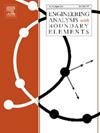Comparative study of face-based smoothed point interpolation method and linear finite element method for elastoplastic and large deformation problems in geomaterials
IF 4.2
2区 工程技术
Q1 ENGINEERING, MULTIDISCIPLINARY
Engineering Analysis with Boundary Elements
Pub Date : 2024-09-21
DOI:10.1016/j.enganabound.2024.105969
引用次数: 0
Abstract
Nonlinear deformation of geomaterials is one of the important problems in geotechnical engineering. Compared with the finite element method (FEM), meshfree face-based smoothed point interpolation method (FSPIM) has a more exact stiffness and low mesh dependence, which shows great potential in simulating the nonlinear deformation of geomaterials. Compared with the linear FEM, this paper studies the calculation accuracy and efficiency of FSPIM with the T4 scheme for elastoplastic and large deformation problems in geomaterials. This paper first derives the elastoplastic and large deformation SPIM, including the smoothing deformation gradient, smoothing Green–Lagrange strain, the discrete updated Lagrangian governing equation, and elastoplastic constitutive relations that eliminate the effects of rigid body motion. Then, two effective analysis programs are developed for comparative analysis based on the FSPIM and linear FEM. Two classical slope models with different geometrical parameters and constitutive models are employed for numerical tests. Based on the numerical test results, the performance of FSPIM in the analysis of elastoplastic and large deformation problems in geomaterials is evaluated by comparing it with the linear FEM. Finally, the simulation results are discussed, and future work of the FSPIM is proposed.
面基平滑点插值法与线性有限元法在土工材料弹塑性和大变形问题中的比较研究
岩土材料的非线性变形是岩土工程中的重要问题之一。与有限元法(FEM)相比,无网格面平滑点插值法(FSPIM)具有更精确的刚度和更低的网格依赖性,在模拟土工材料的非线性变形方面显示出巨大的潜力。与线性有限元相比,本文研究了采用 T4 方案的 FSPIM 对弹性和大变形问题的计算精度和效率。本文首先推导了弹塑性和大变形 SPIM,包括平滑变形梯度、平滑格林-拉格朗日应变、离散更新拉格朗日控制方程和消除刚体运动影响的弹塑性构成关系。然后,基于 FSPIM 和线性有限元,开发了两种有效的分析程序进行对比分析。在数值测试中采用了两种具有不同几何参数和构成模型的经典斜坡模型。根据数值测试结果,通过与线性有限元进行比较,评估了 FSPIM 在分析土工材料的弹塑性和大变形问题时的性能。最后,对模拟结果进行了讨论,并对 FSPIM 的未来工作提出了建议。
本文章由计算机程序翻译,如有差异,请以英文原文为准。
求助全文
约1分钟内获得全文
求助全文
来源期刊

Engineering Analysis with Boundary Elements
工程技术-工程:综合
CiteScore
5.50
自引率
18.20%
发文量
368
审稿时长
56 days
期刊介绍:
This journal is specifically dedicated to the dissemination of the latest developments of new engineering analysis techniques using boundary elements and other mesh reduction methods.
Boundary element (BEM) and mesh reduction methods (MRM) are very active areas of research with the techniques being applied to solve increasingly complex problems. The journal stresses the importance of these applications as well as their computational aspects, reliability and robustness.
The main criteria for publication will be the originality of the work being reported, its potential usefulness and applications of the methods to new fields.
In addition to regular issues, the journal publishes a series of special issues dealing with specific areas of current research.
The journal has, for many years, provided a channel of communication between academics and industrial researchers working in mesh reduction methods
Fields Covered:
• Boundary Element Methods (BEM)
• Mesh Reduction Methods (MRM)
• Meshless Methods
• Integral Equations
• Applications of BEM/MRM in Engineering
• Numerical Methods related to BEM/MRM
• Computational Techniques
• Combination of Different Methods
• Advanced Formulations.
 求助内容:
求助内容: 应助结果提醒方式:
应助结果提醒方式:


